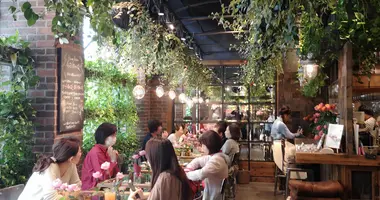8 fugu restaurants in Tokyo
- Published on : 13/06/2024
- by : R.A
- Youtube
Fugu, a puffer fish with a potentially lethal poison, is one of the most fascinating dishes in Japanese cuisine. In Tokyo, the gastronomic capital of the world, thrill-seekers can sample this delicate fish in a number of renowned establishments. Each restaurant offers a unique culinary experience, combining tradition, savoir-faire and creativity. Let's discover eight must-try fugu addresses in Tokyo, where highly skilled chefs transform this dangerous fish into a refined delicacy.
What is fugu and why is it so special?
Fugu fish, also known as puffer or sunfish, is a singular species in Japanese cuisine. Its particularity lies in its natural toxicity: it contains tetrodotoxin, a deadly poison for which there is no antidote. This toxin is found mainly in its organs, notably the liver and ovaries.
Despite this potential danger, fugu is highly prized for its delicate flesh and subtle taste. Preparing it requires special expertise: only chefs who have undergone 2-3 years of special training and obtained a license can prepare it. This rarity and unique know-how make it a luxury delicacy, often associated with special occasions.
Fugu can be enjoyed in a variety of ways: sashimi (thin slices of raw fish), nabe (a kind of Japanese stew), fried or grilled. Each preparation highlights a different facet of its unique texture and flavor.
Tokyo's top fugu restaurants
For an exceptional fugu dining experience in Tokyo, here are a few prestigious addresses:
1. Yamadaya: Located in Hiroo, this three-Michelin-starred restaurant is considered one of the world's finest fugu establishments. Chef Fumie Yamada, who comes from a long line of specialized cooks, offers an elaborate menu highlighting fugu in all its forms. The finesse of the sashimi and the attention paid to every detail make this an unforgettable experience.
2. Tokuyama: Also located in Hiroo, this restaurant offers a more robust cuisine, notably with its fugu zosui (a kind of Japanese risotto). Address: Azabu Empire Mansion B1F, 4-11-28 Nishi-Azabu, Minato-ku, Tokyo. http://tabelog.com/tokyo/A1307/A130703/13002088/.
3. Fukuji: This Ginza restaurant is a benchmark for fugu. Popular with local celebrities, it offers refined cuisine in elegant surroundings. Address: Koda Building 3F, 5-11-3 Ginza, Chuo-ku, Tokyo. http://www.fukuji.jp/
4. Sawaichi: Located in Roppongi, this establishment is renowned for its expert preparation of fugu. It attracts an elite clientele in search of a high-end gastronomic experience. Address: Main Stage Roppongi 1F, 3-9-11 Roppongi, Minato-ku, Tokyo. http://sawaichi.jp/.
Tokyo's more affordable fugu restaurants
For those wishing to sample fugu without breaking the bank, Tokyo also offers more affordable options:
5. Sandaime Uokama: This 75-year-old institution in Asakusa offers fresh fugu at affordable prices. Renowned for its longevity and safety (no casualties in 75 years!), it's an excellent option for the curious. Address: 3-20-5 Kuramae, Taito-ku, Tokyo. http://uokuma.com/.
6. Wadatsumi: Located in Ikebukuro, this restaurant specializes in fugu sashimi. It even offers a discount if you book the day before. Address: 2-12-5 Ikebukuro, Toshima-ku, Tokyo. http://tabelog.com/tokyo/A1305/A130501/13033008/dtlphotolst/1/smp2/.
7. Chiba: Also in Ikebukuro, this restaurant offers a rare fugu lunch menu. You can enjoy a full menu for just 1,000 yen. Address: 4-24-8 Higashi Ikebukuro, Toshima-ku, Tokyo. http://tabelog.com/tokyo/A1305/A130501/13080431/dtlphotolst/1/smp2/.
8. Kikuchi: Located in Ueno, this restaurant offers some of the best value for money fugu in Tokyo. Menus start at 4,000 yen and offer generous portions. Address: Kameda Building 1F, 1-12-2 Ueno, Taito-ku, Tokyo. http://tabelog.com/tokyo/A1311/A131101/13160356/.
How to choose a fugu restaurant safely
When it comes to choosing a fugu restaurant in Tokyo, safety should be your top priority. Here are a few tips to help you make the right choice:
1. Check certifications: Make sure the restaurant has the necessary licenses to serve fugu. Chefs must have undergone special training and obtained official certification.
2. Look for reviews: Consult online reviews and reputable gastronomic guides such as Michelin to get an idea of the restaurant's quality and reputation.
3. Observe popularity: A fugu restaurant frequented by locals is generally a good sign. The Japanese are very demanding when it comes to quality and food safety.
4. Avoid cheap offers: Fugu is a luxury food. An exceptionally low price could indicate a lack of quality or safety.
5. Ask for advice: Don't hesitate to ask your hotel or local acquaintances for recommendations. They'll be able to point you in the right direction.
Different ways to enjoy fugu
Fugu can be prepared in a variety of ways, each offering a unique taste experience:
1. Sashimi (fugusashi): This is the most common preparation. The fugu is sliced into thin, transparent strips, often arranged in the shape of a chrysanthemum. This presentation allows you to fully appreciate the delicate texture of the fish.
2. Fugu no karaage: Fried fugu is a tasty option. Pieces of fish are coated in flour and fried until crisp on the outside and tender on the inside.
3. Fugu nabe: This Japanese stew is perfect for chilly evenings. Fugu is cooked in a broth with vegetables, creating a comforting and tasty dish.
4. Fugu no hire-zake: This is a grilled fugu fin served in hot sake. This unique drink is appreciated for its complex taste and comforting warmth.
5. Fugu no shirako: For the more adventurous, fugu milt is considered a delicacy, often served raw or lightly cooked.
Fugu restaurant prices and reservations
Prices at fugu restaurants in Tokyo vary considerably, depending on the reputation of the establishment and the type of menu chosen:
- In high-end restaurants like Yamadaya, a meal can easily cost between 20,000 and 30,000 yen per person (around 150 to 225 euros).
- Mid-range restaurants generally offer menus between 10,000 and 15,000 yen (75 to 110 euros).
- More affordable options, such as Chiba in Ikebukuro, offer lunch menus from 1,000 yen (approx. 7.50 euros).
As far as reservations are concerned, it's strongly recommended to book in advance, especially for the most famous restaurants. The peak season for fugu is generally from October to March, and reservations can be difficult to obtain during this period.
Some restaurants may require a deposit or credit card to guarantee a reservation, especially for groups. Don't hesitate to ask your hotel for help with reservations if you don't speak Japanese.
Tips for a unique fugu dining experience in Tokyo
To make the most of your fugu experience in Tokyo, here are a few tips:
1. Choose the right season: Fugu is best during the winter months, from November to February, when the fish is fatter and tastier.
2. Opt for a tasting menu: Many restaurants offer omakase (chef's choice) menus that allow you to taste fugu in different forms.
3. Pair your meal with sake: Fugu goes particularly well with sake, especially hire-zake (fugu fin grilled in hot sake).
4. Take your time: A meal of fugu is an experience to be savored slowly. Enjoy every bite and appreciate the chef's expertise.
5. Dare to be adventurous: If you're curious, try less common parts of the fugu, such as the skin or milt (shirako).
6. Respect etiquette: In high-end restaurants, a dress code may be required. Find out in advance.
7. Start a conversation: If possible, talk to the chef or staff. They'll be able to tell you more about the history and preparation of fugu.
By following these tips, you'll ensure a memorable fugu dining experience in Tokyo, combining unique flavors with Japanese culinary tradition.




































